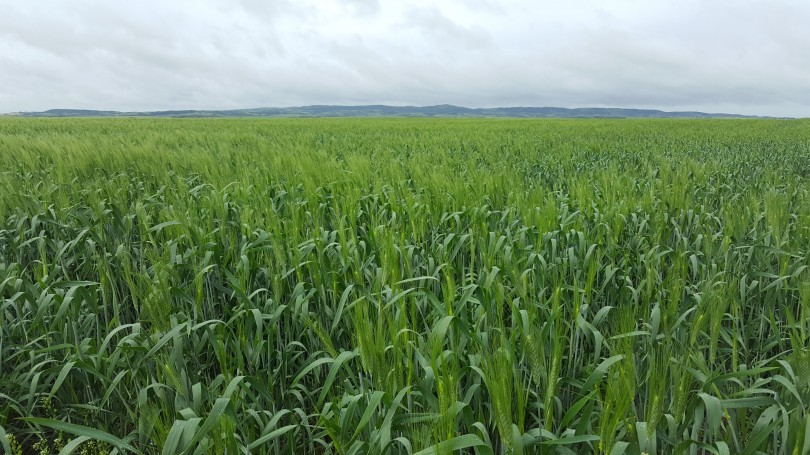Durum wheat can be a great option for growers within specific geographies who want to take advantage of contract premiums that may be available with buyers who have high demand for this premium wheat. Durum is used to produce high-quality pasta, couscous and other baked goods in countries around the world.
Below is some information for a refresher on the durum growing region, moisture needs of durum and diseases in durum, along with variables worth considering to make sure the durum variety you select for your farm is the best choice to meet your needs.
What to Consider When Choosing a Durum Variety
Geography
One of the biggest limitations on durum wheat is geography. Canada is the world’s leading exporter of durum wheat, but most durum produced in Canada is grown in what is called “the Palliser Triangle,” or “Palliser’s Triangle.”
Drought in Durum
The Palliser Triangle encompasses southeastern Alberta and southwestern and south Saskatchewan. This area is well known for being prone to drought.
If you want to learn more about how moisture stress can impact yield in durum, check out this blog post from Behind the Seeds that examined the impact of moisture levels on durum yields in 2018.
Drought is a significant concern for all durum crops not necessarily because drought is harder on durum then other types of wheat, but simply because virtually all durum grown in Canada is exposed to moisture stress in The Palliser Triangle. On the Prairies, we have now experienced three consecutive growing seasons with low rainfall in-season, leading to extreme drought conditions. These consistently dry conditions have both some advantages and disadvantages to durum production.
Drought and Rust Pressure in Durum
This region, prone to drought as it is, is the only suitable region in Canada for durum production in part because the dry conditions make for reduced disease pressure on the crop.
Rust diseases can be decimating to durum wheat crops – stem rust, leaf rust and stripe rust can all cause significant yield loss and quality reduction. One could say durum was “chased” into the Palliser Triangle by rust pressure, as the crop could not be successfully and profitably grown elsewhere.
In the present day, not only is the risk of rust much lower for durum due to its growing region, but all CANTERRA SEEDS durum varieties have at least an “MR” rating for moderate resistance to each of the three rusts mentioned above.
CDC Credence from CANTERRA SEEDS has leading rust resistance with R ratings across the board for all three types of rust.
Durum Varieties for Dryland and Irrigation
While some durum is grown on dryland conditions relying on timely rainfall events, some durum is grown under irrigation conditions. Whether or not your operation uses irrigation can impact the ideal type of durum variety to select for your farm.
- Dryland – When growing durum on dryland, I recommend choosing a taller variety with a shorter maturity time. A short time to maturity will help your durum avoid significant drought stress in the later season.
- Irrigation – If you are growing durum using irrigation, you may be considering a semi-dwarf durum variety to take advantage of increased yield potential. Semi-dwarf durum is less prone to lodging and requires intensive management with higher rates of chemical, fertilizer and consistent moisture. Semi-dwarf varieties are not likely to yield well or even survive if exposed to significant moisture stress. But, if you have irrigation, the benefits of a semi-dwarf variety can make it worthwhile for your farm.
Whether you grow on dryland or use an irrigation system, I recommend AAC Congress from CANTERRA SEEDS. This mid-maturity, medium height variety is well-suited to both types of growing conditions. Click here to view independent trial data on AAC Congress performance near Candiac, Sask.
FHB and DON in Durum
Arguably the most dangerous pest in durum wheat today is fusarium head blight (FHB). This fungal disease is also known as “scab” and it affects cereal grains including wheat, barley, oats and rye among others. When FHB infects a crop, it creates fusarium damaged kernels (FDK) and leads to the development of mycotoxins like “deoxynivalenol” (DON). These toxins can severely limit the end-use options for your durum.
DON is very toxic and can be deadly to both humans and animals, so not only can DON lower grain grade beyond what is fit for human consumption, it can also make the crop unfit for some animal feed uses.
Because DON can have such significant health effects, many countries have strict regulations on DON levels in wheat imports. You can visit keepingitclean.ca to learn more about managing FHB to maintain crop marketing opportunities.
DON and Grain Grading
As you know, the Canadian Grain Commission grades grain on a scale of 1 to 5, with 1 and 2 being grain for human consumption. As high-quality wheat known for making premium pasta and bread products, durum needs to fall in these top two grades.
Durum with 2% FDK would be graded at 3 to 4, which would not be fit to sell for the end-use purposes we need. Anything with 5% or higher FDK is not fit for classification.
Something to keep in mind is that a low level of FHB infection does not necessarily mean low levels of DON, as FDK can still accumulate high rates of DON.
Choosing Durum in Regard to DON Levels
When comparing durum varieties and specifically thinking about DON levels, I recommend looking for a variety that indicates “low DON accumulation” to give you the best chance to produce a crop that could meet a 1 or 2 grade.
Both CDC Credence and AAC Congress from CANTERRA SEEDS have low DON accumulation, making them good choices if your area has a history of FHB infection. All three Prairie provinces release annual FHB risk maps. Click the links below to get the most recent information on FHB risk for your province:
FHB Resistance
Unfortunately, there is no true resistance to FHB in cereals. Most new milling wheat varieties have been able to achieve MR, moderate resistance to FHB. Durum wheat breeders have mentioned that durum might not have the same genetic mechanisms of resistance that milling wheat does, and durum is still “struggling” with susceptible ratings.
Some durum varieties are rated MS for “moderately susceptible” to FHB. An MS variety gives you just a bit of added resistance compared to an S rated durum.
CDC Credence is a good example of a durum variety with increased resistance to FHB. It carries an MS* rating, so it does offer some additional protection to FHB that you would not get from an S or even MS rated durum variety.
Final Thoughts on Choosing a Durum Variety
From moisture stress to disease pressure, there is a lot to consider when choosing your durum variety. At the end of the day, no matter what variety you choose, I recommend building a strong agronomic plan and doing everything you can to make sure your durum crop is as healthy as possible.
As a premium crop for human consumption, durum requires very careful management to realize its high value. Durum being a profitable option for the farm depends on capturing that grain grade of 1 or 2, and this should be achievable as long as your crop is healthy.
If you have any questions about choosing a durum variety to fit your farm, contact your local CANTERRA SEEDS Territory Manager.
Ready to purchase your durum today? Use our seed locator tool to find a retailer near you.
 Cosmin Badea, Pedigreed Seed Product Development Manager, has been with CANTERRA SEEDS for over five years. He makes sure that CANTERRA SEEDS has the right pedigreed products at the right time and in the right place, meaning that he is responsible for adding new and valuable pedigreed varieties for our seed portfolio based on farmer demands and end-user trends.
Cosmin Badea, Pedigreed Seed Product Development Manager, has been with CANTERRA SEEDS for over five years. He makes sure that CANTERRA SEEDS has the right pedigreed products at the right time and in the right place, meaning that he is responsible for adding new and valuable pedigreed varieties for our seed portfolio based on farmer demands and end-user trends.


